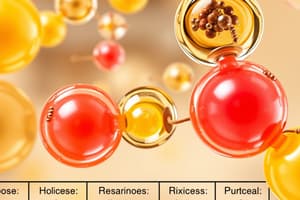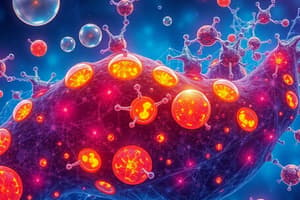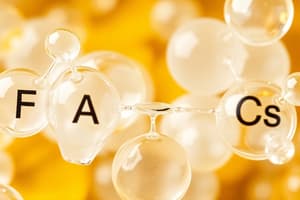Podcast
Questions and Answers
What are the three main roles of lipids?
What are the three main roles of lipids?
- Cell structure (correct)
- Hormone production (correct)
- DNA synthesis
- Energy storage (correct)
What is a fatty acid?
What is a fatty acid?
Lipid and building block for more complex lipids.
What is the structure of triglycerides?
What is the structure of triglycerides?
Glycerol backbone with 3 fatty acid chains.
What is a phospholipid?
What is a phospholipid?
Where are glycolipids found in the body?
Where are glycolipids found in the body?
What is an important function of sphingolipids?
What is an important function of sphingolipids?
What is the structure of steroids?
What is the structure of steroids?
What do terpenes consist of?
What do terpenes consist of?
What is the function of waxes in plants and animals?
What is the function of waxes in plants and animals?
What is the chemical composition of prostaglandins?
What is the chemical composition of prostaglandins?
What is an adipocyte?
What is an adipocyte?
What role does Vitamin A play in vision?
What role does Vitamin A play in vision?
What does Vitamin D promote in the body?
What does Vitamin D promote in the body?
What are the primary functions of Vitamin E?
What are the primary functions of Vitamin E?
What are the other names for Vitamin K?
What are the other names for Vitamin K?
What is saponification?
What is saponification?
What is sphingosine?
What is sphingosine?
Flashcards
Lipids: Function
Lipids: Function
Nonpolar molecules, crucial for energy storage, cell structure (membranes), and vitamin/hormone precursors.
Fatty Acids: Structure
Fatty Acids: Structure
Lipid building blocks, typically even-numbered carbon chains; either saturated (single bonds) or unsaturated (double bonds).
Triglycerides: Function
Triglycerides: Function
Energy storage, insulation, and organ padding; glycerol backbone with three fatty acids.
Phospholipids: Structure
Phospholipids: Structure
Signup and view all the flashcards
Glycolipids: Location
Glycolipids: Location
Signup and view all the flashcards
Sphingolipids: Structure
Sphingolipids: Structure
Signup and view all the flashcards
Steroids: Structure
Steroids: Structure
Signup and view all the flashcards
Terpenes: Structure
Terpenes: Structure
Signup and view all the flashcards
Waxes: Function
Waxes: Function
Signup and view all the flashcards
Prostaglandins: Function
Prostaglandins: Function
Signup and view all the flashcards
Adipocytes: Function
Adipocytes: Function
Signup and view all the flashcards
Vitamin A: Origin
Vitamin A: Origin
Signup and view all the flashcards
Vitamin D: Role
Vitamin D: Role
Signup and view all the flashcards
Saponification: Process
Saponification: Process
Signup and view all the flashcards
Sphingosine: Structure
Sphingosine: Structure
Signup and view all the flashcards
Study Notes
Lipid Classification
- Lipids are nonpolar molecules that serve three main roles: energy storage, cell structure (membranes), and as precursors to vitamins and hormones.
Fatty Acids
- Fatty acids are lipids that act as building blocks for more complex lipids.
- Typically contain an even number of carbon atoms and can be either saturated (with single bonds) or unsaturated (with double bonds).
- Release significant energy when C-H bonds are broken; commonly reach tissues as free fatty acids.
Triglycerides
- Composed of a glycerol backbone bonded to three fatty acid chains.
- Functions include energy storage, thermal insulation, and mechanical padding for organs.
Phospholipids
- Structurally similar to triglycerides but with one fatty acid replaced by a phosphate group, resulting in an amphipathic molecule (having both hydrophilic and hydrophobic properties).
- Play a critical role in forming biological membranes.
Glycolipids
- Contain one or more carbohydrates attached to glycerol, also making them amphipathic.
- Predominantly found in the membranes of myelinated cells within the nervous system.
Sphingolipids
- Based on an amino alcohol backbone with a long-chain fatty acid.
- Integral components of cell membranes and are associated with the ABO blood group antigens on red blood cells as glycosphingolipids.
Steroids
- Characterized by a four-ring structure composed of three cyclohexane rings and one cyclopentane ring.
- Includes hormones, cholesterol (crucial for membrane fluidity and stability), and Vitamin D.
Terpenes
- Built from two isoprene units (C5H8).
- Function as integral parts of body pigments, including Vitamin A, and serve as precursors for steroids and lipid signaling molecules.
Waxes
- Created through the ester linkage of long-chain fatty acids and long-chain alcohols.
- Exhibit water-repellent properties, protecting plants from evaporation and parasites and aiding in moisture retention in animals.
Prostaglandins
- Eicosanoids consisting of a 20-carbon unsaturated carboxylic acid and a five-carbon ring.
- Produced by nearly all body cells and function as local hormones affecting various physiological processes like blood pressure, body temperature, smooth muscle contraction, and sleep-wake cycles.
Adipocytes
- Specialized fat cells predominantly filled with triglycerides.
- Commonly found under the skin, around mammary glands, and within the abdominal cavity.
Vitamins Derived from Lipids
- Vitamin A (Carotene): A terpene that is converted into retinal, essential for vision.
- Vitamin D (Cholecalciferol): A steroid that is metabolized into calcitriol, facilitating calcium and phosphorus absorption for bone health.
- Vitamin E (Tocopherols): Known for its antioxidant properties, scavenging free radicals.
- Vitamin K (Phylloquinone and Menaquinones): Vital for prothrombin formation (a clotting factor) and the introduction of calcium-binding sites on certain proteins.
Saponification
- Refers to the hydrolysis of triglycerides using a base, resulting in soap formation—specifically, salts of free fatty acids.
Sphingosine
- An 18-carbon amino alcohol with an unsaturated hydrocarbon structure, featuring both an NH2 group and an alcohol group.
Studying That Suits You
Use AI to generate personalized quizzes and flashcards to suit your learning preferences.




